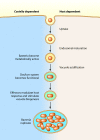The Coxiella burnetii Dot/Icm system creates a comfortable home through lysosomal renovation
- PMID: 22010216
- PMCID: PMC3195215
- DOI: 10.1128/mBio.00226-11
The Coxiella burnetii Dot/Icm system creates a comfortable home through lysosomal renovation
Abstract
Understanding the molecular pathogenesis of Coxiella burnetii, the causative agent of human Q fever, has historically been hindered by the technical difficulties of genetically manipulating obligate intracellular bacteria. The recent development of culture conditions suitable for axenic propagation of C. burnetii has paved the way for the application of a range of genetic techniques to address key questions within the field. Recent studies using mutational analysis have revealed that the C. burnetii Dot/Icm type 4 secretion system (T4SS) is an important virulence determinant that is essential for renovation of a lysosome into a mature Coxiella-containing vacuole (CCV) permissive of intracellular replication. Interestingly, a mutant of C. burnetii deficient in Dot/Icm function was found to be capable of replicating within the parasitophorous vacuole created by Leishmania amazonensis, which indicates that C. burnetii replication is not dependent on the cohort of Dot/Icm effector proteins per se but rather that the collective actions of effectors are required to create the specialized niche supportive of replication. Thus, a role for the Dot/Icm T4SS during the intracellular life cycle of C. burnetii has been more clearly defined by these studies, which demonstrate that advances in genetic analysis should allow future studies to focus on the intricacies of Dot/Icm effector functions that facilitate development of the unique CCV.
Figures

Similar articles
-
Dot/Icm-Translocated Proteins Important for Biogenesis of the Coxiella burnetii-Containing Vacuole Identified by Screening of an Effector Mutant Sublibrary.Infect Immun. 2018 Mar 22;86(4):e00758-17. doi: 10.1128/IAI.00758-17. Print 2018 Apr. Infect Immun. 2018. PMID: 29339460 Free PMC article.
-
Effector protein translocation by the Coxiella burnetii Dot/Icm type IV secretion system requires endocytic maturation of the pathogen-occupied vacuole.PLoS One. 2013;8(1):e54566. doi: 10.1371/journal.pone.0054566. Epub 2013 Jan 17. PLoS One. 2013. PMID: 23349930 Free PMC article.
-
A screen of Coxiella burnetii mutants reveals important roles for Dot/Icm effectors and host autophagy in vacuole biogenesis.PLoS Pathog. 2014 Jul 31;10(7):e1004286. doi: 10.1371/journal.ppat.1004286. eCollection 2014 Jul. PLoS Pathog. 2014. PMID: 25080348 Free PMC article.
-
Biogenesis of the lysosome-derived vacuole containing Coxiella burnetii.Microbes Infect. 2015 Nov-Dec;17(11-12):766-71. doi: 10.1016/j.micinf.2015.08.006. Epub 2015 Aug 29. Microbes Infect. 2015. PMID: 26327296 Free PMC article. Review.
-
Molecular pathogenesis of the obligate intracellular bacterium Coxiella burnetii.Nat Rev Microbiol. 2013 Aug;11(8):561-73. doi: 10.1038/nrmicro3049. Epub 2013 Jun 24. Nat Rev Microbiol. 2013. PMID: 23797173 Free PMC article. Review.
Cited by
-
The Effector Cig57 Hijacks FCHO-Mediated Vesicular Trafficking to Facilitate Intracellular Replication of Coxiella burnetii.PLoS Pathog. 2016 Dec 21;12(12):e1006101. doi: 10.1371/journal.ppat.1006101. eCollection 2016 Dec. PLoS Pathog. 2016. PMID: 28002452 Free PMC article.
-
Coxiella burnetii Lipopolysaccharide: What Do We Know?Int J Mol Sci. 2017 Nov 23;18(12):2509. doi: 10.3390/ijms18122509. Int J Mol Sci. 2017. PMID: 29168790 Free PMC article. Review.
-
Alterations of the Coxiella burnetii Replicative Vacuole Membrane Integrity and Interplay with the Autophagy Pathway.Front Cell Infect Microbiol. 2017 Apr 24;7:112. doi: 10.3389/fcimb.2017.00112. eCollection 2017. Front Cell Infect Microbiol. 2017. PMID: 28484683 Free PMC article.
-
Computational modeling and experimental validation of the Legionella and Coxiella virulence-related type-IVB secretion signal.Proc Natl Acad Sci U S A. 2013 Feb 19;110(8):E707-15. doi: 10.1073/pnas.1215278110. Epub 2013 Feb 4. Proc Natl Acad Sci U S A. 2013. PMID: 23382224 Free PMC article.
-
Biogenesis of the Spacious Coxiella-Containing Vacuole Depends on Host Transcription Factors TFEB and TFE3.Infect Immun. 2020 Feb 20;88(3):e00534-19. doi: 10.1128/IAI.00534-19. Print 2020 Feb 20. Infect Immun. 2020. PMID: 31818957 Free PMC article.
References
-
- Zamboni DS, McGrath S, Rabinovitch M, Roy CR. 2003. Coxiella burnetii express type IV secretion system proteins that function similarly to components of the Legionella pneumophila Dot/Icm system. Mol. Microbiol. 49:965–976 - PubMed
-
- Hubber A, Roy CR. 2010. Modulation of host cell function by Legionella pneumophila type IV effectors. Annu. Rev. Cell Dev. Biol. 26:261–283 - PubMed
Publication types
MeSH terms
Substances
Grants and funding
LinkOut - more resources
Full Text Sources

